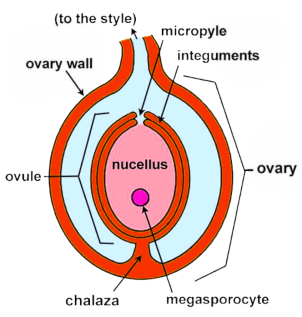
Which of the following floral parts forms pericarp after fertilization?
A. Nucellus
B. Outer integument
C. Ovary wall
D. Inner integument
Answer
321.6k+ views
Hint: The pericarp, commonly referred to as the fruit wall, is a component of the fruit of angiospermic plants. Only angiosperms produce fruit throughout the whole plant kingdom. The fruit is covered by pericarp and this develops after fertilization from the ovary wall.
Step by step solution:
The fact that the blooms turn into fruits following fertilisation is already known to us. The female reproductive organ of the plant, the ovary, develops into a fruit that contains the seed that has grown from the ovules. The outer layer of a fleshy fruit is called the pericarp. The walls of the ovary make up the pericarp. It encircles the ovules or environmental seeds. Testa refers to the seed's outer sheath.
In higher plants, it will aid in defending the embryo against harmful environmental factors. It is believed that the testa's primary role is to regulate germination during dormancy. Typically, the testa seed coat is rigid and firm. When the environmental conditions are right, it will aid in seed germination.
Tegmen is the name of the covering that lies beneath the testa. The seed is directly protected by it. When folded, the principal purpose is to shield the seed's hindwings.
The ovule's inner integument portion grows into the seed's tegmen. Perisperm is the nutritive tissue layer that develops from Nucellus. The perisperm surrounds the seed embryo in angiosperms. It serves no purpose for seeds or dried goods.

Hence, the correct option is C. Ovary wall
Additional information:
In the case of fleshy fruit, the pericarp is separated into three layers:
Epicarp- It’s the outermost layer and form the outermost skin of the fruit.
Mesocarp- It’s considered as the middle layer of the fruit.
Endocarp- It’s the innermost layer which surrounds the seed.
Note: The flowering plant is divided into various components. The three main components are the seed, ovule, and ovary. Each part has a set of related parts. Some plants just produce seeds (like grapes), while others grow meaty fruits from their seeds (like apples, oranges, etc.). Different layers of seed and ovule perform a different function. The components that are present throughout growth will be transformed into additional components to create a fruit.
Step by step solution:
The fact that the blooms turn into fruits following fertilisation is already known to us. The female reproductive organ of the plant, the ovary, develops into a fruit that contains the seed that has grown from the ovules. The outer layer of a fleshy fruit is called the pericarp. The walls of the ovary make up the pericarp. It encircles the ovules or environmental seeds. Testa refers to the seed's outer sheath.
In higher plants, it will aid in defending the embryo against harmful environmental factors. It is believed that the testa's primary role is to regulate germination during dormancy. Typically, the testa seed coat is rigid and firm. When the environmental conditions are right, it will aid in seed germination.
Tegmen is the name of the covering that lies beneath the testa. The seed is directly protected by it. When folded, the principal purpose is to shield the seed's hindwings.
The ovule's inner integument portion grows into the seed's tegmen. Perisperm is the nutritive tissue layer that develops from Nucellus. The perisperm surrounds the seed embryo in angiosperms. It serves no purpose for seeds or dried goods.

Hence, the correct option is C. Ovary wall
Additional information:
In the case of fleshy fruit, the pericarp is separated into three layers:
Epicarp- It’s the outermost layer and form the outermost skin of the fruit.
Mesocarp- It’s considered as the middle layer of the fruit.
Endocarp- It’s the innermost layer which surrounds the seed.
Note: The flowering plant is divided into various components. The three main components are the seed, ovule, and ovary. Each part has a set of related parts. Some plants just produce seeds (like grapes), while others grow meaty fruits from their seeds (like apples, oranges, etc.). Different layers of seed and ovule perform a different function. The components that are present throughout growth will be transformed into additional components to create a fruit.
Recently Updated Pages
Capping is a process in which A adenylate is added class 12 biology NEET_UG

Explain in brief the separation and isolation of DNA class 12 biology NEET_UG

Number of testicular lobules in testes is A 250 B 500 class 12 biology NEET_UG

Master Class 11 Accountancy: Engaging Questions & Answers for Success

Master Class 11 Science: Engaging Questions & Answers for Success

Master Class 11 Business Studies: Engaging Questions & Answers for Success

Trending doubts
What is BLO What is the full form of BLO class 8 social science CBSE

Differentiate between an exothermic and an endothermic class 11 chemistry CBSE

Which places in India experience sunrise first and class 9 social science CBSE

What are the major means of transport Explain each class 12 social science CBSE

Which are the Top 10 Largest Countries of the World?

How many millions make a billion class 6 maths CBSE




